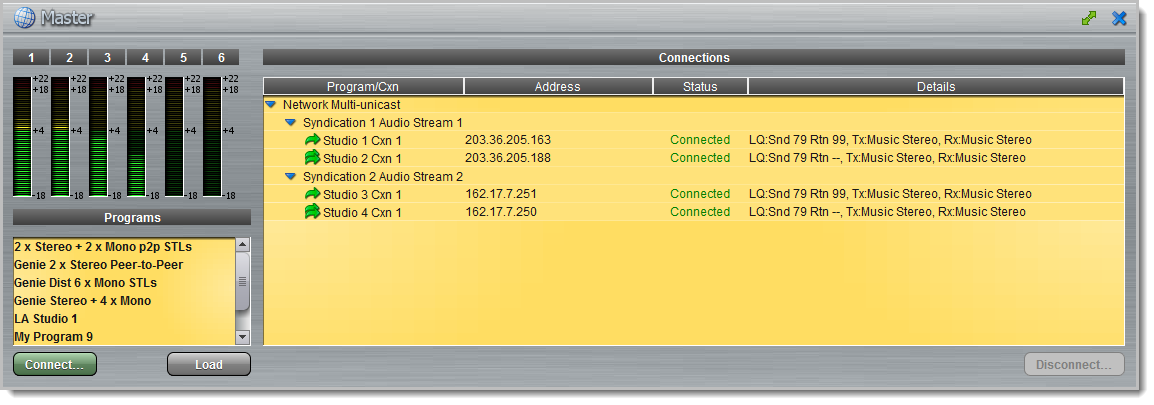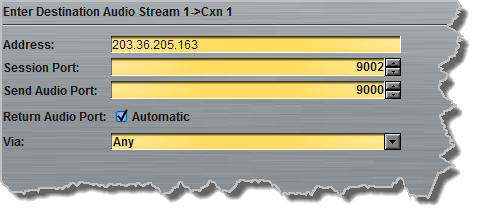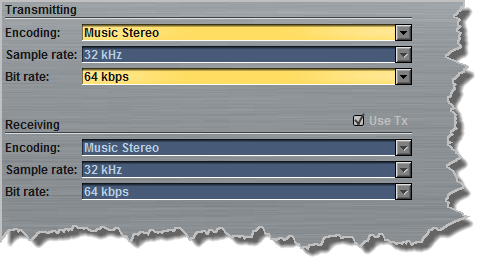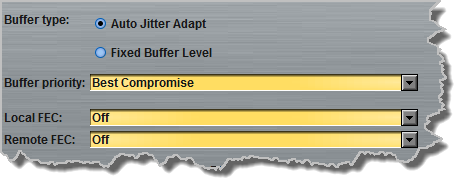Configure Multi-Unicast Dialing Programs
Genie Distribution can also simultaneously send up to 3 different mono or stereo multi-unicast audio streams to a maximum of 50 endpoints in total. For example, the first stream could be sent to 10 endpoints, the second stream to 15 endpoints and the last stream could be sent to 25 endpoints. The first connection from each multi-unicast audio stream is capable of bidirectional audio.
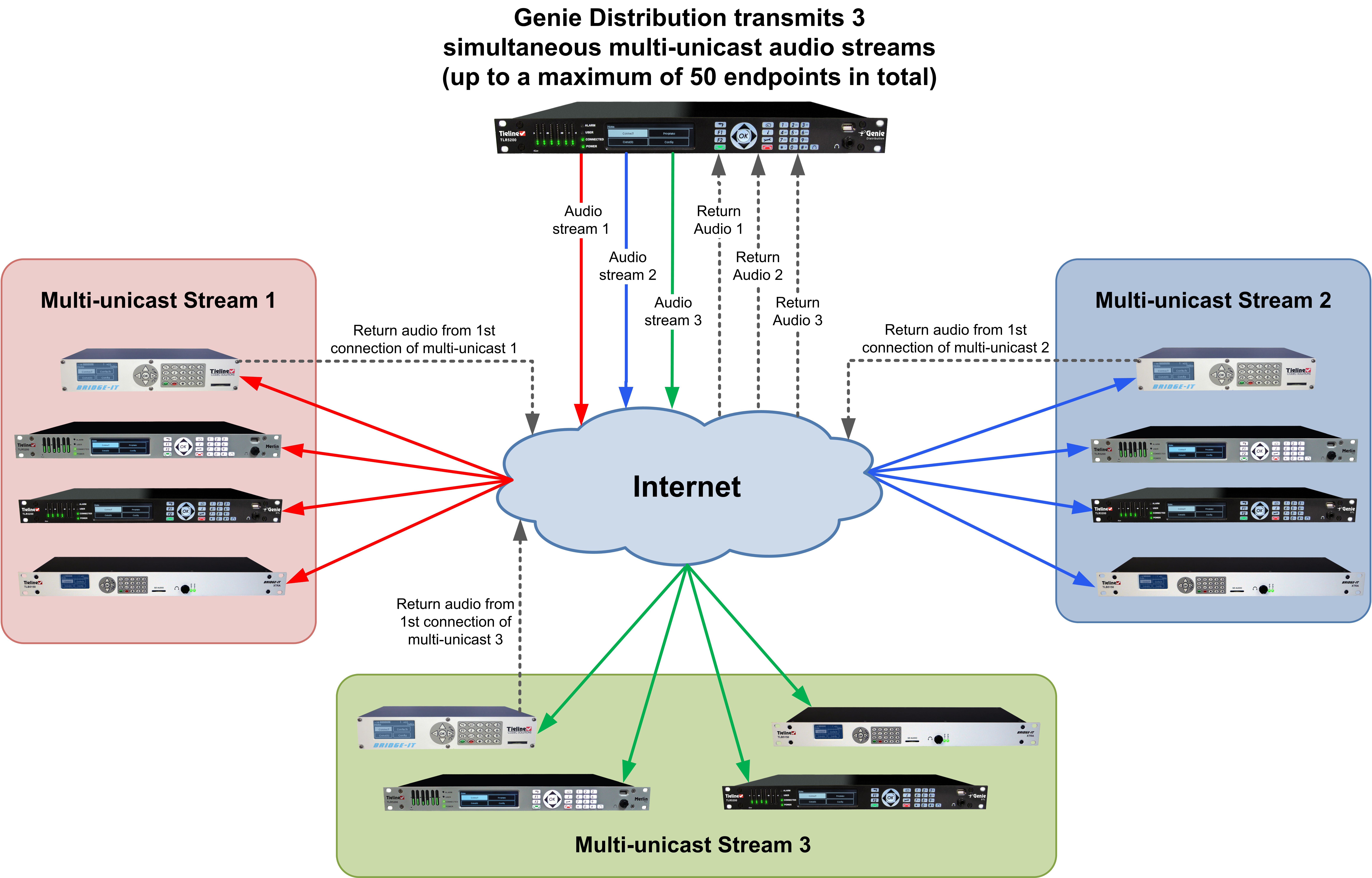
|
Important Notes: Before you start program configuration please note: •You cannot edit a program when it is currently loaded in the codec. •You can lock a loaded custom program in a codec to ensure the currently loaded program cannot be unloaded by a codec dialing in with a different program type. •If you are dialing to both G3 and Bridge-IT, Merlin or Genie codecs, by default the Audio Reference Level will be configured for the compatibility of the codec dialed first. I.e. if you dial a G3 codec first then the G3 Audio Reference Level will be configured for all connections. •Connections are dial only for multi-unicast programs. •Some drop-down menus and settings may be greyed out intentionally depending on features available. •It is possible to save a program at several points throughout the program wizard and use default settings to save configuration time. The first connection in each multi-unicast stream determines default settings (e.g. algorithm, sample rate, bit rate), for all subsequent connections in that stream, except for dialing settings. •All algorithms are supported for multi-unicast connections, however only one can be used for each audio stream. •Bidirectional audio is only available on the first connection dialed. •Forward Error Correction (FEC) is not available on multi-unicast connections. •Renegotiation of connection bit rates is not possible when connected. •Ensure you have sufficient connection bandwidth at the local codec to support all the connections to which you are connecting. •SmartStream PLUS is not available for multi-unicast connections. •If a codec is answering more than one mono or stereo multi-unicast connection it is necessary to create an answering program to suit the answering configuration and lock this program in the codec. •To learn more about programs see the section titled About Program Dialing. |
Creating a Multi-Unicast Program
1.Open the Java Toolbox Web-GUI and click the Programs ![]() symbol at the top of the screen to display the Programs panel.
symbol at the top of the screen to display the Programs panel.
2.Click the New Program symbol to open the wizard and then:
•Click in the text box to name the new program.
•Select Multi-unicast, 2x Multi-unicast, 3 x Multi-unicast, or if you want to use an existing program as a template, select this option. Then click Next. Note: In this example we will create a 2 x Multi-unicast program.
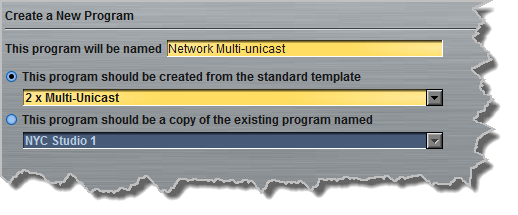
|
Important Note: When you decide to use an existing program as a template, the new program inherits all the settings of the template program and you can adjust these settings as required by continuing through the program wizard. |
3.Enter a name for the Audio Stream and then click Next.

4.This audio stream connection in the wizard will allow the codec to dial. Enter the name of the connection in the text box, then click Next.
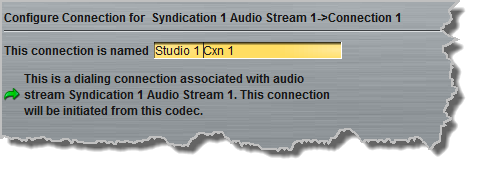
5.Follow the instructions on the right-hand side of the panel to configure the transport settings for the connection, then click Next. Note: only the first connection dialed in a multi-unicast program can encode and decode audio. All other connections are unidirectional and encode only.
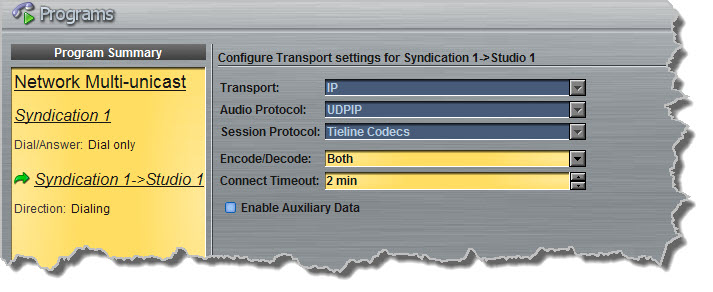
|
Important Note: Bidirectional auxiliary IP data is available on one audio stream when configuring 2 or 3 x Multi-Unicast dialing programs. When auxiliary data is enabled on one stream the option is greyed out for other audio streams in the program wizard. Auxiliary IP data connections are not possible between the codec and G3 Commander and i-Mix codecs over multi-unicast connections. See RS232 Data Configuration for detailed information on RS232 data and see Enabling Relays and RS232 Data for more information on relay operations. |
6.Configure destination codec dialing and encoding settings:
|
For IP connections configure the IP address, ports, and then specify which streaming interface is used to dial this connection, e.g. Primary (port ETH1) or Secondary (port ETH2). Note: By default Any will select ETH1 if it is available and ETH2 if it is unavailable.
Click Save Program to save the program with the default algorithm, jitter and FEC settings which are physically entered in the codec. Alternatively, click Next to specify individual algorithm, jitter buffer and FEC settings (recommended).
Click the drop-down arrows on the right-hand side of each text box to adjust the Encoding, Sample rate or Bit rate options.
Click to configure: •Auto Jitter Adapt and the preferred auto jitter setting using the drop-down arrow for Buffer priority, or •Fixed Buffer Level and enter the Jitter Depth, which must be between 12ms and 5000ms depending on the algorithm you select. •Local and Remote FEC settings if required.
|
7.Select the Enable Auto Reconnect check-box if you want to enable this feature.

8.Select the Create another dialing connection check-box to configure another connection, then click Next.
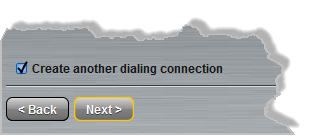
9.Enter the name of the second connection in the text box, then click Next.
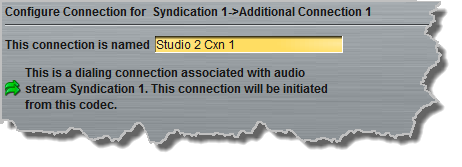
10.Continue through the program wizard and configure all multi-unicast connections. After all connections are configured, select the Enable Output File Playback on silence detection check-box if you want to enable this feature.
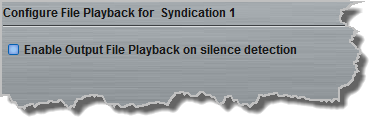
11.Click Save Program to save the program settings when configuring a 1 x Multi-unicast program.
|
Important Notes: For 2 x Multi-unicast and 3 x Multi-unicast programs, configure new audio streams and connections as required in the same way as the first multi-unicast audio stream.
Audio Send Port 9000 is configured by default for the first audio stream's connections. A second audio stream (2 x Multi-unicast programs and 3 x Multi-unicast programs) uses Audio Send Port 9010 by default; a third audio stream (3 x Multi-unicast programs) uses Audio Send Port 9020. |
The newly created program will be displayed in the left pane within the Programs panel and in the Master panel. Select and connect audio streams in a program using the Master panel, or dial the program manually using the codec front panel.
Monitoring Multi-Unicast Programs
The Master panel in the ToolBox Web-GUI is used to monitor connection details and view PPMs, as displayed in the following image. Click the blue arrow ![]() in the Program/Cxn column to expand and minimize multiple connection details for a program that you dial (as displayed below).
in the Program/Cxn column to expand and minimize multiple connection details for a program that you dial (as displayed below).
